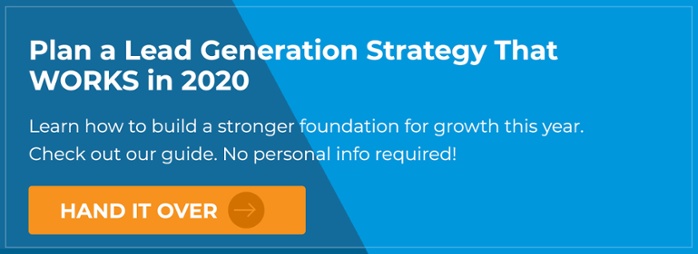
Let's End the Debate Over B2B Marketing ROI
Patrick Dodge
Founder

The marketing campaign is over, and it’s time to make an honest assessment.
What did it do for your parent company or clients? This is not always an easy conversation to have.
Marketers often find themselves in a frustrating, elliptical “discussion” about whether the campaign produced a return on investment, which seeds doubt in the minds of the people they are reporting to.
Let’s put an end to this debate by establishing a few rules of engagement before the campaign gets underway.
Make Sure All Parties Agree What ROI Means
As silly as this sounds, marketers often try to demonstrate ROI without having an agreed upon method of defining success. You need to agree on how to measure ROI before you can prove it.
The conventional formula looks something like this:
ROI = (Profit) – (Campaign Expenses) / (Campaign Expenses)
Our friends at Track Maven wrote about this, and made the important observation that the aggregate effect of content marketing over time can impact your short-term results, making it tricky to isolate the ROI of a single campaign.
In HubSpot's 2017 Ultimate List of Marketing Statistics, 75 percent of their blog views come from old posts. Chances are good your most popular articles will be topics that have a long shelf life, and they typically revolve around common questions customers ask. Cost is usually the biggest one.
It's important to note that while you are measuring the short-term impact of your marketing campaign, it could pay dividends for months or years down the road. Marcus Sheridan, partner at IMPACT (formerly of The Sales Lion), offers a great example of this. He has attributed millions of dollars in sales to a single blog post his fiberglass pool company wrote almost ten years ago.
I would use the simple ROI equation above, but also make sure that everyone understands that your campaign could benefit from previous marketing initiatives whose costs have already been accounted for.
Set SMARTer Goals for B2B Lead Generation

Now that we have a formula for measuring ROI, we need to set useful goals for the campaign.
I've seen many situations where marketers doomed themselves to failure because there are no clear expectations to meet.
If you run an analysis after the campaign is over and determine the ROI is $10, will that mean you were successful? You may as well take the ten bucks and buy yourself a hot lunch, because you might not get another one for a while.
We all know what a SMART goal is. We understand the value of setting a specific objective and a timeline within which to achieve it, but people still miss the mark with this.
Saying we are going to grow our business by 12% next year is not a good goal.
It leaves too many questions unanswered, and no discernible path for marketers to follow to reach the objective.
I recommend setting a marketing goal that looks more like this:
“We are going to increase business by 12% next year, adding $3 million in incremental revenue, and 26 new customers to fill that gap. In order to do this, we will generate 200 new leads by increasing our website traffic to 50,000 views.”
See the difference there? Not only do you have a specific revenue target to hit, you also have a roadmap to follow that will help you get there. For more tips about setting productive goals, check out our ungated, step-by-step guide to planning a better lead capture strategy.
Break Down Your Performance Metrics
Next, we set some benchmarks we will help us get to our goal, defined by new customers, leads, and website traffic. Let's talk a little more about these individually.
- Traffic
Before you can generate new leads, you are going to need website traffic, and lots of it.
It could come from a variety of sources of course, including organic search engine traffic, paid search, social media, referral sites, email marketing, and other sources. A well coordinated campaign will likely include most of these channels, with a concentration on the few that convert at the highest level.
Organic search traffic tends to generate more leads than any other source, so focusing on frequent and consistent content creation is a crucial part of delivering ROI. Even today, with so much content saturation on the Internet, blogging is still the most effective way to build website traffic and convert visitors into leads.
Start by calculating how much traffic you need to generate the required number of leads. Unless you have better metrics to go by, it's safe to assume that approximately 2-3% of your visitors will convert into leads if the proper conversion paths are in place.
If you need 300 leads to demonstrate ROI, shoot for 10,000 visits on your website.
- CTA clicks
CTAs, or calls-to-action, are buttons on your website that prompt the user to action, converting them into leads.
Measuring your CTA percentages are very important for measuring the effectiveness of different offers on your website. Through testing and experimentation, you should strive to achieve a 4-5% click-through-rate, and increase it as you go.
There are a few different tools you can use to measure CTA performance. If you aren’t using a marketing automation platform, Lead Pages is a low-cost option that's useful for creating CTAs, plugging them into your website, and monitoring real-time conversion data.
- Conversions
Conversions are defined by the number of times the user has taken an action that moves them deeper into your sales funnel.

Many people mistakenly point to the number of conversions as proof their campaign was successful, yet their clients and employers are unimpressed. They want customers, not leads. Conversions are important for understanding the health of a campaign, but they are not an end goal. Leads need to be nurtured before they become customers.
This is why it's a bad idea to use a CTA like “Contact Us” on a blog post. Most visitors are looking for information. They aren't interested in talking to a salesperson.
A good marketing campaign not only acknowledges the needs of your buyer personas, but also the stage of the buyers journey they are in. This same principle applies as you try to nurture leads throughout your campaign. By sending them highly relevant, contextual messages that help them get to the next stage of their problem-solving, you can bring them back to your site to explore new ways of meeting their challenges and goals.
You are developing a relationship with these people, and gaining insights to send them personalized messages that show you understand what they are trying to accomplish and can provide excellent resources to help them get there.
- Customers
Customers are the only true metric that matters at the conclusion of a marketing campaign.
Not every customer is the same, of course. Some of them will spend less than the average, while others will invest in a bigger solution.
This is why it's important to calculate the average customer spend during the goal setting process and dividing that number into your overall revenue target. This will give you a safe number of customers to shoot for.
It's also a good idea to consider your average customer lifetime value as you calculate ROI at the end of your campaign. For instance, a customer that spends $50,000 a year will help you this year, and future ones as well. If an average customer stays with your company three years, they are worth $150,000. This is an important consideration as you discuss ROI.
You Need a Marketing Automation Platform
Measuring ROI is tough without an all-in-one marketing automation platform, like HubSpot.
These tools allow you to monitor your campaign metrics from one dashboard, giving you fast, easy insights into which channels are driving traffic, leads, and customers.

Marketing automation is not cheap, but if your company or clients are serious about getting ROI from their marketing, they should make at least a minimal investment in a platform that suits them and scale up as they go.
If you don’t have marketing automation, you will likely have to use several different tools to measure performance.
In most cases, these disparate tools don't talk to each other and you're going to spend a lot of effort trying to make a coherent picture out of that data. You also run the risk of discrepancies in the data itself. This is the most important reason why B2B brands should invest in a marketing platform that makes sense for their companies.
Feb 8, 2018 7:53:46 AM

